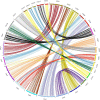QTL mapping of yield-related traits in sesame
- PMID: 37309387
- PMCID: PMC10236103
- DOI: 10.1007/s11032-021-01236-x
QTL mapping of yield-related traits in sesame
Abstract
Improving yield is one of the most important targets of sesame breeding. Identifying quantitative trait loci (QTLs) of yield-related traits is a prerequisite for marker-assisted selection (MAS) and QTL/gene cloning. In this study, a BC1 population was developed and genotyped with the specific-locus amplified fragment (SLAF) sequencing technology, and a high-density genetic map was constructed. The map consisted of 13 linkage groups, contained 3528 SLAF markers, and covered a total of 1312.52 cM genetic distance, with an average distance of 0.37 cM between adjacent markers. Based on the map, 46 significant QTLs were identified for seven yield-related traits across three environments. These QTLs distributed on 11 linkage groups, each explaining 2.34-71.41% of the phenotypic variation. Of the QTLs, 23 were stable QTLs that were detected in more than one environment, and 20 were major QTLs that explained more than 10% of the corresponding phenotypic variation in at least one environment. Favorable alleles of 38 QTLs originated from the locally adapted variety, Yuzhi 4; the exotic germplasm line, BS, contributed favorable alleles to only 8 QTLs. The results should provide useful information for future molecular breeding and functional gene cloning.
Supplementary information: The online version contains supplementary material available at 10.1007/s11032-021-01236-x.
Keywords: Genetic map; QTL; Sesamum indicum L.; Yield-related traits.
© The Author(s), under exclusive licence to Springer Nature B.V. 2021.
Conflict of interest statement
Conflict of interestThe authors declare no competing interests.
Figures



Similar articles
-
High-density linkage map construction and QTL analyses for fiber quality, yield and morphological traits using CottonSNP63K array in upland cotton (Gossypium hirsutum L.).BMC Genomics. 2019 Nov 21;20(1):889. doi: 10.1186/s12864-019-6214-z. BMC Genomics. 2019. PMID: 31771502 Free PMC article.
-
A high-density genetic map constructed using specific length amplified fragment (SLAF) sequencing and QTL mapping of seed-related traits in sesame (Sesamum indicum L.).BMC Plant Biol. 2019 Dec 27;19(1):588. doi: 10.1186/s12870-019-2172-5. BMC Plant Biol. 2019. PMID: 31881840 Free PMC article.
-
High-density genetic map construction and QTLs analysis of grain yield-related traits in sesame (Sesamum indicum L.) based on RAD-Seq techonology.BMC Plant Biol. 2014 Oct 10;14:274. doi: 10.1186/s12870-014-0274-7. BMC Plant Biol. 2014. PMID: 25300176 Free PMC article.
-
QTL mapping in sesame (Sesamum indicum L.): A review.J Biotechnol. 2023 Nov 10;376:11-23. doi: 10.1016/j.jbiotec.2023.09.003. Epub 2023 Sep 15. J Biotechnol. 2023. PMID: 37717598 Review.
-
Discovering favorable genes, QTLs, and genotypes as a genetic resource for sesame (Sesamum indicum L.) improvement.Front Genet. 2022 Nov 1;13:1002182. doi: 10.3389/fgene.2022.1002182. eCollection 2022. Front Genet. 2022. PMID: 36544489 Free PMC article. Review.
Cited by
-
Current Progress, Applications and Challenges of Multi-Omics Approaches in Sesame Genetic Improvement.Int J Mol Sci. 2023 Feb 4;24(4):3105. doi: 10.3390/ijms24043105. Int J Mol Sci. 2023. PMID: 36834516 Free PMC article. Review.
-
Improved assembly and annotation of the sesame genome.DNA Res. 2022 Dec 1;29(6):dsac041. doi: 10.1093/dnares/dsac041. DNA Res. 2022. PMID: 36355766 Free PMC article.
-
Sesame, an Underutilized Oil Seed Crop: Breeding Achievements and Future Challenges.Plants (Basel). 2024 Sep 23;13(18):2662. doi: 10.3390/plants13182662. Plants (Basel). 2024. PMID: 39339635 Free PMC article. Review.
-
QTL analysis of traits related to seed size and shape in sesame (Sesamum indicum L.).PLoS One. 2023 Nov 2;18(11):e0293155. doi: 10.1371/journal.pone.0293155. eCollection 2023. PLoS One. 2023. PMID: 37917626 Free PMC article.
References
-
- Ashri A. Sesame breeding. In: Janick J, editor. Plant breeding reviews. New York: Wiley; 1998. pp. 179–228.
-
- Ashri A (2007) Sesame (Sesamum indicum L.) In: Singh RJ (ed) Genetic resources, chromosome engineering and crops improvement: oilseed crops, Vol. 4. CRC, Boca Raton, pp 231–289
-
- Bedigian D, Harlan JR. Evidence for cultivation of sesame in the ancient world. Econ Bot. 1986;40:137–154. doi: 10.1007/BF02859136. - DOI
-
- Burt AJ, Grainger CM, Smid MP, Shelp BJ, Lee EA. Allele mining of exotic maize germplasm to enhance macular carotenoids. Crop Sci. 2011;51:991–1004. doi: 10.2135/cropsci2010.06.0335. - DOI
LinkOut - more resources
Full Text Sources

